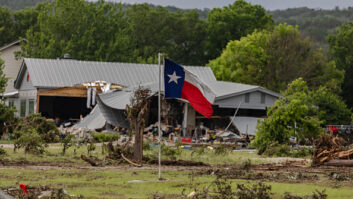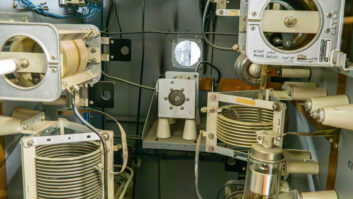Question: I have been reading about RF survey instruments and RF personal monitors and see the term “shaped-frequency response.” What does that mean?
Answer: The shaped-frequency response technology patented by Narda many years ago has proven to be extremely valuable when measurements are needed at sites where there are multiple transmitting systems operating at different frequencies with potentially different exposure limits. It is also a key component of the most popular RF personal monitors.
(click thumbnail)Most people are aware that the FCC’s Maximum Permissible Exposure (MPE) limits vary with frequency. For example, the MPE limit for Occupational/Controlled exposure is 1 mW/cm2 from 30 MHz to 300 MHz. The exposure limit is 100 mW/cm2 below 3 MHz and 5 mW/cm2 above 1,500 MHz. The MPE limits in between follow straight-line relationships and vary with frequency.
Because of this, it is often not enough to simply know the magnitude of the field strength. If you are at a site with a single transmitting antenna, such as an AM radio station, you don’t have a problem — the limit is 100 mW/cm2. Similarly, if you are at a site with only FM antennas, the limit is 1 mW/cm2. The best probe sensors and the sensors in personal monitors correctly add the energy from multiple sources, and since the MPE limit is the same throughout the FM band, there are no problems determining compliance and safety.
Problems occur when antenna systems operate at frequencies with different exposure limits. An extreme, but very real, example is a site with an FM antenna mounted on an AM antenna tower. To make things simple, let’s assume that these are the only two sources in the area. If you were to use a conventional probe that measured all frequencies equally and found that a particular area has an equivalent power density of 5 mW/cm2, what would that tell you in terms of compliance and safety? Not much!
The only way to asses the situation would be to power down one of the stations and make a measurement. Then, you could use the differential to apportion the energy between the AM and the FM station. But if you don’t do that, you have no way of determining the contribution from each station.
Try it
Let’s take two versions of this extreme example and do some simple math.
In the first situation, assume that the contribution from the AM antenna is 4.9 mW/cm2 and the contribution from the FM antenna is 0.1 mW/cm2. The area is evaluated by converting each of the values to a percentage of the MPE limit and then adding the two percentages. In this case, you get 4.9 percent (4.9/100) and 10 percent (0.1/1) for a total of 14.9 percent. In this situation, you don’t have a problem and are well below the MPE limit.
In the second situation, we’ll simply reverse the contributions. Assume the contribution from the AM antenna is only 0.1 mW/cm2 while the contribution from the FM antenna is 4.9 mW/cm2. Do the same type of calculations and you’ll get 490.1 percent of the MPE limit.
These calculations are based on the MPE limit for Occupational/Controlled exposure. The MPE limits for General Population/Uncontrolled exposure yield even more extreme results. This is because the public MPE limit for the FM band is 0.2 mW/cm2 while the limit for most of the AM band — the limit begins to decrease at 1,340 kHz — is also 100 mW/cm2.
Shaped-frequency response sensors are designed with resistive-capacitive (RC) circuits using design techniques similar to filter design. The sensitivity of the sensors attempt to follow a particular standard or regulation, such as the FCC Regulations.
For example, if you use the Nardalert XT RF personal monitor and it is exposed to an RF field from an FM antenna that is 1.0 mW/cm2, it will interpret that as 100 percent of the standard, and audible and visual alarms are activated accordingly. If the monitor is exposed to the same intensity field from an AM station, it will interpret the signal as 1 percent of standard. Note that the monitors all follow the higher MPE limits for Occupational/Controlled exposure.
If you exposed the monitor to the energy from multiple sources operating at different frequencies with different exposure limits, the monitor still yields results in terms of total percentage of the MPE limit. Shaped-frequency response probes are used to make measurements at complex sites without the need to turn anything off. The approach is to simply make sure that everything is operating at full power.
Write to the author at[email protected]. Comment on this or any article to[email protected].








